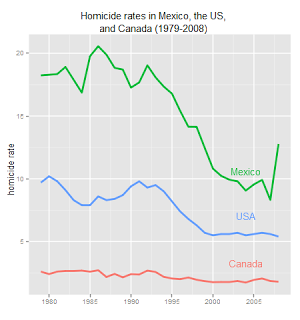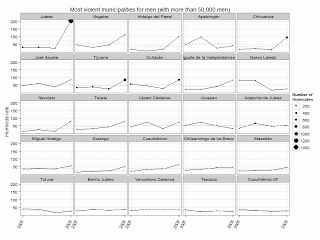Just today the Mexican government released to the public the mortality database for 2009, and as you can see from the chart Mexico has suffered from a steep rise in homicides from 2008 onward and very likely reached the highest violence rate in recent history last year. Since the Mexican government also recently made available a database of homicides presumably linked with the drug war we can divide homicides into those related to the drug war an those that are not:
Tag: homicide | Atom Feed
I’ve written before about how I couldn’t find the Acteal Massacre in the homicide database available at the INEGI. So I decided to check if the deaths that occurred as a consequence of the massacre were misclassified as other types of violent death,
Since the Mexican Human Rights Commission is working on a report of femicides in Mexico, but were only able to access data from the police forces of 18 states, I reran the program I used to analyze the homicides in Ciudad Juárez with data for all femicides.
The only problem is that since I’m using the death certificate database from the vital statistics system, and it takes time to gather all death certificates, I only have data up to the last day of December 2008 (the 2009 vital statistics are supposed to come out during late November/ early December)
There has been a lot of attention paid to the role of US guns exacerbating the violence in Mexico. The assault-weapon ban expired on September 14, 2004, but with the recent spiraling of violence in Mexico the ban has attracted renewed attention. Just recently the Mexican President stood before the American Congress and blamed the assault weapon ban for the rising violence in Mexico, seemingly without proof. This post will try to clarify some of the issues surrounding the controversy.
I think it would be fair to say that the conventional wisdom by scholars who have studied the ban would be the one Christopher Koper, Daniel Woods and Jeffrey Roth stated: “We cannot clearly credit the ban with any of the nation’s recent drop in gun violence.” In other words, the assault weapon ban had no significant effect—at least where the United States is concerned. And as far as I know there are no studies of the effect of the ban expiration on Mexico.
As is well known, gun control is politically charged issue, not only in the United States, but also in Mexico. For example, after two students died in a shootout between the army and cartel gunmen, the rector of what is arguably Mexico’s best university stated:
For me [Rangel Sostmann] the solution is that Mexico and the United States must change their policies. And the policy right now is for the United States to send the money and weapons, and Mexico puts the dead and the drugs. And that ultimately is not going to work, it’s not a question of driving the Army out, the problem is that you have to change the policies, in this case the United States policy.Later an investigation by the National Human Rights Commission concluded that the army had used excessive force, impeded the investigation, planted weapons on the students, possibly tortured them for several minutes, and then shot them at point blank range. The day after the report was released, the ITESM bestowed upon the Secretary of Defense the “AdHonorem” award, given to persons whose works have contributed in an outstanding manner to the “the fight against injustice.” As you can see gun control has become extremely politicized, to say the least.
—Rangel Sostmann, ITESM Campus Rector
With politics hopefully out of the way, let’s look at the homicide data with a seasonal decomposition by loess:
As you can see from the charts there was an increase in the number of homicides and homicides with firearm that coincided with the expiration. The big drop at the start of 2007 was due to the military operations in Michoacan and Acapulco, and also to a temporary drop in the homicide rate of Mexico City (which had nothing to do with the drug war).
Last year there were over 2,600 murders in Ciudad Juarez, and if the more than 1,800 murders so far this year are any indications, there will be even more murders in 2010. Ciudad Juarez is a scary place, but it wasn’t always that way…
I learned from Noel Maurer’s Blog that Ciudad Juarez used to have a low murder rate before 1993, but it rose steeply after the local leader of the Juarez Cartel, Aguilar Guajardo, died, and Amado Carillo replaced him. After Amado Carrillo had firmly established himself thing calmed down somewhat, but by then the violence had switched to a new equilibrium. But anyways, go read Noel Maurer’s take on it
The director of the CISEN, the Mexican agency in charge of generating intelligence to safeguard Mexico’s security, said in a presentation yesterday that the number of homicides linked to the drug war was a little over 28,000 since the start of the Calderon administration.
Guillermo Valdés didn’t provide the raw data so I used Engauge to digitize the slide with the homicide data from the presentation:
I’ve been complaining about how homicide statistics from police sources were too low in 2009, with the entire state of Chihuahua having less homicides than its biggest city. I was thinking of finding out if I could use the IFAI (Freedom of Information Access) to obtain the original CIEISP forms which the state police forces are supposed to fill out each month and send to the National System of Public Security (SNSP) for tallying, to see if there were any unusual patterns, but someone beat me to requesting the data.
You can see the request here, and download the excel file with the CIEISP forms here.
The main difference between the datasets is that the CIEISP forms usually report lower numbers than the data the SNSP gave to the ICESI. This is not surprising since the CIEISP forms have no recorded homicides in some states during the last months of the year (the request was made in December 2009), but the numbers for Chihuahua in both datasets are identical, with a total of 2523 homicides recorded. More importantly, in the months of November and December there were no homicides registered in the CIEISP forms, and the data for October looks incomplete. That’s the reason Chihuahua had such a low homicide rate according to the police, the data they gave to the ICESI only includes 9¾ months of homicides.
I’m surprised by how similar the trends are (excluding the drug war in Mexico). There were big decreases in the homicide rate in all three countries starting in the early nineties, which then slowed down around 2000.
The municipalities are ordered by their peak homicide rate and the dotted gray line is the average homicide rate over the 2005–2008 period. Since homicide is mostly a male phenomenon it’s not surprising to find Ciudad Juarez is the most violent city for men.
Unless otherwise stated, the content of this page is licensed under the Creative Commons Attribution 3.0 License, and code samples are licensed under the Apache 2.0 License. Privacy policy
Disclaimer: This website is not affiliated with any of the organizations or institutions to which Diego Valle-Jones belongs. All opinions are my own.
Special Projects:
- Mexico Crime Rates - ElCri.men: Monthly Crime Report for all of Mexico
- Mexico City Crime - HoyoDeCrimen.com: Geospatial crime map of Mexico City
- Mexico City Air Quality - HoyoDeSmog
Blogs I like:








